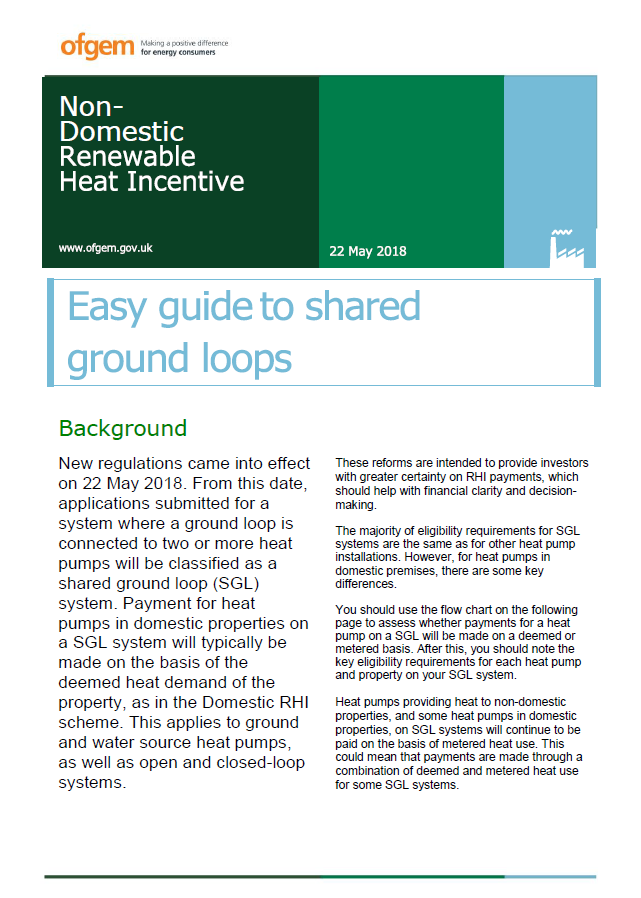Commercial Ground Source Heat Pump Shared Ground Loop Systems
Take advantage of the financial rewards available from the Non-Domestic Renewable Heat Incentive
What is a Shared Ground Loop?
Usually, most people think about ground source heat pumps in houses each having their own individual, mechanically separate, ground loop. However, it is also possible to connect multiple ground source heat pumps to one ground loop array. Take this idea one step further, and it enables the possibility to have multiple neighbouring properties all connected to one communal ground loop array.
In short, a shared ground loop is one which has 2 or more properties heated by individual ground source heat pumps connected to it.
Shared ground loops provide a fantastic solution for ground source heat pumps, combining all the benefits of individual, self-contained heat pumps with the economies of scale and flexibility of a communal ground loop.
Shared Ground Loops and the Non-Domestic RHI
The most significant benefit of shared ground loop systems is that they are classed by Ofgem as district heating installations rather than individual heat pump installations. As such, heat pumps installed with shared ground loops are eligible for the Non-Domestic RHI, rather than the usual Domestic RHI.
“New regulations came into effect on 22 May 2018. From this date, applications submitted for a system where a ground loop is connected to two or more heat pumps will be classified as a shared ground loop (SGL) system. ”
NEW Build
All new build developments are eligible for the non-domestic RHI.
Under the Domestic RHI, new builds are usually ineligible for the scheme unless they are classed as custom builds. In contrast, the Non-Domestic RHI does not have any eligibility criteria relating to whether the project is new build as retrofit.
This means that for example, a developer building 2 neighbouring properties heated by ground source heat pumps, connected to a shared ground loop, would be eligible for the Non-Domestic RHI.
The Ofgem factsheet on Shared Ground Loops is available at the bottom of this page.
Deemed payments
A further benefit of Shared Ground Loop systems is that payments under the Non-Domestic RHI scheme are deemed. Usually with traditional district networks - where one large system is feeding multiple houses - the payments are based on metered heat usage. Heat metering adds additional cost as well as an additional obligation for reporting to Ofgem. Furthermore, investors will not have absolute security on the payback, because fundamentally the payments will be based on actual usage.
For Shared Ground Loop systems, Ofgem have decided to make payments based on Deemed Usage. This is more akin to the Domestic RHI, where the payments are based on the heat requirement figures on the home’s Energy Performance Certificate. This provides investors with an absolute figure on which repayments can be made, and as such investors can feel secure as to the level of repayment.
Other Benefits of Shared Ground Loops
DIVERSITY
When designing ground loops, you need to consider two factors: the annual energy requirement for the property; and the peak extraction rate of energy from the ground. If you have two heat pumps connected to the same ground loop, whilst the annual energy requirement will simply be the sum of the two, the peak extraction rate won’t be, because it is highly unlikely that the two properties will be extracting their energy at exactly the same time.
Now, the effect of diversity with just two properties is negligible, however as you scale this up the impact becomes much more profound. As such, larger projects can benefit from significant economies of scale by operating a shared ground loop.
Billing
With traditional district heating schemes, there is an onus on the developer or landlord to meter the amount of heat used in each property and bill for it. This is not only a significant undertaking, but also provides a credit risk. With Shared Ground Loop schemes, each property has it’s only ground source heat pump connected to the property’s main electricity supply. As such, each homeowner or resident is responsible for paying their own heating bills in the conventional fashion.
Individual heating system
For a developer looking to sell properties on, it is major selling point for a house for it to have it’s own, self-contained heating system. This is achieved with a Shared Ground Loop scheme, because it’s home has it’s own independent ground source heat pump. It’s only connection is to the Shared Ground Loop, but conceptually this is no different to a gas boiler being connected to the gas network, which is a concept readily accepted by homeowners.
HAVE A NEW DEVELOPMENT AND CONSIDERING GROUND SOURCE HEAT PUMPS?
Ofgem Factsheet
Easy Guide to Shared Ground Loops
Site Navigation: Home > Commercial
Further Reading:
Commercial Heat Pumps
Commercial Applications
Our Commercial Projects
Alto Commercial Contracting

